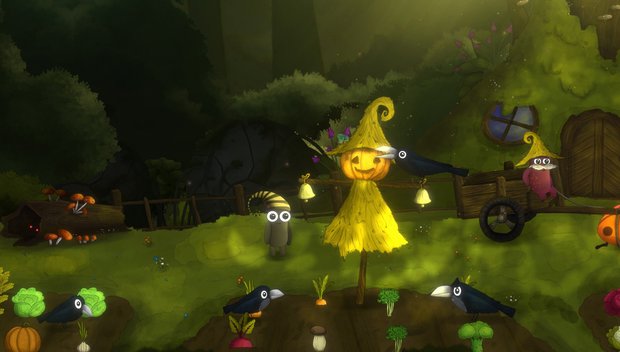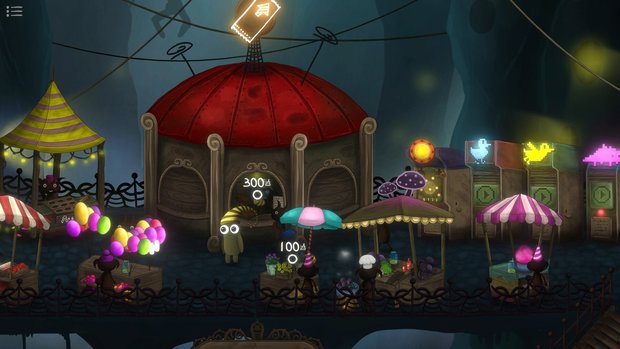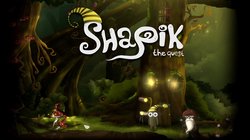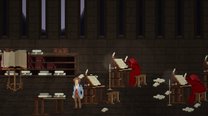Shapik: The Quest review

- 0 Comments
Cozy magical forest puzzler will keep you pleasantly buzzing through its charming self-contained scenarios
In a word, Shapik: The Quest is “cozy.” Cozy embodies the game experience in every facet, from the hand-drawn cartoony graphics with soft colour palette illuminated by golden rays of light, to the relaxed pace of progression, to the charming cast of fairy-tale creatures you interact with. It’s the type of game that demands to be curled up with on a rainy day with a cup of tea. Shapik may not break any new ground – which is hardly a surprise since it’s an enhanced and expanded commercial re-release of a decade-old freeware game – but it’s nevertheless a delightful adventure that will surely keep you charmed for the entirety of its brief runtime.
Much like the developer’s similar but unrelated Shapik: The Moon Quest, the game is a cartoon pantomime, though this one stars small, elf-like creatures living in a magical forest. The titular protagonist lives in a hollowed-out tree trunk with their sister in a quiet part of the woods – at least until Shapik’s sister is kidnapped, as seen in the introductory slideshow. Shapik is helpless to do anything but watch in horror as she is caught in a net trap and hoisted up and away, but quickly regains their footing and sets out to rescue their captive sibling.

The first character you meet is a bumblebee caught in a net of another kind – a spider’s web outside Shapik’s home. Reaching the bee acts as a sort of short tutorial, outlining the simple two-click controls and points of interaction. Once you free the bee, it is so grateful for your help that it opts to put its skin (erm, fuzz?) in the game and accompany you on your quest.
While the story lacks any written dialogue, it’s an easy enough setup to follow as the pair’s odyssey through the forest sees them meet new friends who help them on their quest. It doesn’t always make sense why something is happening, like early on when you meet an old-timer who seemingly has no problem letting you take his flying machine (whether or not Shapik knows this person prior to the game is never shared), but what is transpiring is never unclear. Supporting characters don’t stick around for long either, keeping the pace brisk and the narrative relatively straightforward. It’s somewhat evocative of Amanita Design’s Machinarium in story and tone (though its natural setting is more like Samorost), and if you enjoy Amanita’s style of storytelling, Shapik will be right up your alley.
Another thing Shapik shares in common with Machinarium is the ability to access hard-to-reach places. Just as the little robot Josef could extend his body, Shapik’s bumblebee companion also acts as a physical extension. A bumblebee icon connotes hotspots out of Shapik’s reach in the environment, frequently prompting you to use your insect companion’s gift of flight to solve puzzles by buzzing around and bumping into things. Environments are small, and finding points of interest is easy, with icons connoting interactivity automatically popping up as you enter their vicinity.
Shapik is subdivided into 21 scenes, many of which are only a single screen. The game moves from the forest floor to farmland, swamps, high cliff sides, and deep mines, and each area has been crafted with care to look atmospherically distinct. There is no inventory per se, though Shapik can pick up and carry a single item to use elsewhere. All the clues and keys you’ll need to complete any given screen are never more than a few steps from one another, though that’s not to say you won’t spend a few minutes mulling over how the puzzle pieces in each scene fit together.

Puzzles range greatly in variety, including everything from finding symbols to open a combination lock, chasing crows out of a farmer’s field, disabling a robot guard, making a tea recipe, or operating heavy machinery. Each and every obstacle challenges you in a new way, and while not overly long, the thought put into making every sequence unique is notable. Some of these tasks are less puzzly and more action-based, like a section where you operate a train by charging up a battery while controlling a throttle to reach your destination as quickly as possible. There is no penalty for going slow, but sequences like this help inject a little energy into an otherwise relaxed pace. There is a slight, gradual increase in the difficulty of puzzles, though given the limited size of both the environments and your abilities, the game is on the easy side overall.
One section at a fair requires you to obtain enough tokens to pay for a tram ride to your next destination. In order to do so, you must play a handful of carnival games, gambling your tokens in the hopes of obtaining more. There is a free-to-play whack-a-mole game that will get you started, but obtaining all of the tokens needed to progress from this minigame alone would take ages, so it’s best to spread out and try your luck after stocking up a small reserve. Other activities include a pachinko-style game and a few arcade games with LCD screen graphics. These games operate with a single button (which is actually on-screen, requiring you to click on it) and boil down to making a small avatar jump or fly to avoid obstacles. (One of these games is similar to the infamous Flappy Bird, for example.) They aren’t going to grab your attention for long, but their inclusion is nice. So is the number of shops you can spend some tokens on, which is almost overwhelming at first. I made a few optional purchases in this section, including a souvenir photo for Shapik and the bee, and some flowers for my companion to buzz about in.
The side- (and occasionally vertically-)scrolling Shapik features layered 2D graphics. Everything has an organic curve to it, and the artwork pops like a children’s storybook with its big-eyed, large-headed cartoon creatures animating like paper dolls, and their sprites scaling, compressing and expanding playfully as they move about the environment. Backgrounds are drawn with a nice pastel array of hues, with the greens, blues, yellows and reds of nature contrasting nicely against the greys and browns of industrial props. The camera zooms in and out (you can also do this manually by right-clicking) as you walk, giving an appropriate sense of scope to each area and assisting with the storytelling. Calm atmospheric music plays throughout, capturing that fantasy forest dwelling feel perfectly. Occasionally characters will sigh or gasp, but they never speak.
Navigation can be done solely with the mouse, which works well for adventuring, as the environments are all relatively small, so clicking (or double-clicking to run) is easy enough. Right-clicking a hotspot has Shapik (or the bee) interact with it. Gamepads are supported, but this only serves to have the analog stick take over the cursor and the A button for clicking, so it’s a bit more cumbersome, if anything, and even the arcade games are better suited for a mouse. The game saves at the start of every screen/chapter, and since no one screen is overly long, even if you have to quit mid-puzzle there won’t be much progress lost.
Final Verdict
Shapik took me just under three hours to finish, and that was with taking my time to search for some of the hidden items/achievements (mostly consisting of hidden character cameos and items in the background). But even if short and relatively easy, it’s a cute and satisfying experience while it lasts, and if you miss anything it has enough extra content to justify a second playthrough. Or if you are looking to simply go back and grab something specific, a chapter select is available in the main menu as well. Either way, it won’t take up too much of your time, but if you’re looking for something cozy between more substantial games, Shapik: The Quest is thoughtful and enjoyable in every aspect of its execution, making it an easy recommendation for any skill level or player of any age with an interest in adventure gaming.
Hot take
Shapik: The Quest is a short but delightfully cozy fantasy forest odyssey. What it lacks in challenge and story depth, it more than makes up in its charming presentation and varied, well-choreographed gameplay.
Pros
- Nicely drawn backdrops and animated cast of characters
- Great variety of puzzles and arcade challenges
- Easy to pick up and play or come back to without missing a beat
- Well-paced intertwining of narrative and gameplay keeps you immersed in the adorable fantasy universe
Cons
- Story is simplistic and jumps around a bit, even if it is ultimately easy to follow
Drew played Shapik: The Quest on PC using a review code provided by the game's publisher.











0 Comments
Want to join the discussion? Leave a comment as guest, sign in or register in our forums.
Leave a comment